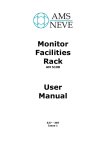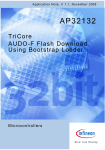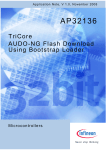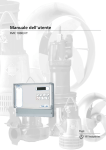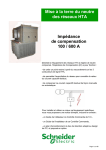Download User Manual
Transcript
Preliminary SMT128 User Manual Preliminary Page 2 of 15 SMT128 User Manual Revision History Date Comments Engineer Version 13/6/00 Initial version AJP 1.0 05/9/00 Second Revision AJP 1.1 07/01/02 Modifications AJP 1.2 26/02/02 Several Modifications Made BM 1.3 Preliminary Page 3 of 15 SMT128 User Manual Table of Contents Revision History.......................................................................................................... 2 Table of Contents ....................................................................................................... 3 Introduction................................................................................................................. 4 Functional Block Diagram........................................................................................... 5 Memory Map............................................................................................................... 6 Virtex Registers .......................................................................................................... 6 WDOG RST ............................................................................................................ 6 WDOG ENABLE ..................................................................................................... 6 DIGIN Register........................................................................................................ 7 DIGOUT Register.................................................................................................... 7 VSTATUS Register ................................................................................................. 7 VCNTRL Register ................................................................................................... 8 FLASH Memory .......................................................................................................... 9 EEPROM .................................................................................................................... 9 UART.......................................................................................................................... 9 Com Port Control...................................................................................................... 10 Token Reset Control Registers ............................................................................. 10 Token Reset Software Functions and Method ...................................................... 10 J21,J24 – Virtext boot mode ................................................................................. 11 J21,J24 – Virtext boot mode ................................................................................. 12 J30 – Flash Write Protect...................................................................................... 12 J27,J28 – Com CPLD User I/O ............................................................................. 12 DIN Connector Pinout............................................................................................... 13 DIN PL1 ................................................................................................................ 13 DIN PL2 ................................................................................................................ 14 Preliminary Page 4 of 15 SMT128 User Manual Introduction The SMT128 is a 3 site TIM carrier card with additional customised features, acting as a supports environment for a DSP TIM and two other peripheral TIM’s. The various ‘on-board’ peripherals available on the motherboard are listed below. • TIM Site 1: Standard Single width TIM site capable of accepting any TIM compatible card. For the most embedded projects this can be a DSP processing card. It has full COMM-PORT and Global Expansion Bus interconnectivity. The site is also capable of accepting C6x based DSP although only four com-ports are available. These com-ports are routed to the PL2 DIN connector for inter-module communication via com-ports (0,1,3,4) via a buffer CPLD. • TIM Site 2: Standard Single Width TIM site with additional 26 way and 24 way IDC sockets, see mechanical/electrical information. This is designed to accept the SMT397 12 channel differential ADC/DAC TIM although other peripheral TIM’s can be used. • TIM Site 3: Standard Single Width TIM site with two additional 24 way IDC sockets, see mechanical/electrical information. This is designed to accept the SMT392 4 channel RS422 Transceiver/Digital IO TIM although other peripheral TIM’s can be used.. • Motherboard Resources/Peripherals • Power Supplies 3.3V, 5V +-15v all generated. • Control FPGA • Digital Inputs/Outputs • Power Monitor & Watchdog • 8K bytes of EEprom that can be used to store application parameters. • JTAG Port • 4Mbit FLASH ram for application Software • Quad UART with links to the DIN connectors and also one to an RS232 connector. The Motherboard has 2 DIN4162 connectors placed at the back of the board which conform with the VME mechanical specifications. The Pin-out out the connectors is given later in this specification. Four of the DSP com-ports are available on the back panel connectors to allow multiple boards to communicate with each other. Each com-port has a control circuitry to allow motherboard in a system to be ‘hot swappable’. Preliminary Page 5 of 15 SMT128 User Manual Functional Block Diagram Analogue TIM Site RS422 TIM Site Digital signal connections to PL1 & PL2 Analogue connections to PL1 Global Resource Bus Front Panel JTAG DSP & PSU Watchdog Eprom 14 TTL I/O’s DSP TIM Site 24 TTL I/O’s 4Mbyte FLASH RAM Controller FPGA DSP Comm-Port PAU 0 1 3 Spartan XC2S100 FG256 4 Power Supplys Quad UART Digital signal connections to PL2 Digital signal connections to PL1 PL2 DIN41612 Back-Panel Connector Key Switch Virtex to PL1 connections PL1 DIN41612 Back-Panel Connector Front Panel Maintenance Port (RS232) Preliminary Page 6 of 15 SMT128 User Manual Memory Map There are four basic motherboard resources, Virtex internal registers, FLASH RAM, EEPROM and UART. Each of these resources is explained in the following sections. Register Global Address Description FLASH Memory 0xA0000000 -> 0xA003FFFF FLASH Application/Boot space EEPROM 0xA8000000 -> 0xA80000FF 8 –bit Non-volatile parameter storage Virtex Registers 0xB0000000 -> 0xB0000007 See Description below UART 1 0xB8000000 -> 0xB8000007 ModBus interface UART 2 0xB8000008 -> 0xB800000F RS232 interface Virtex Registers Register Global Address Description WDOG RST 0xB0000000 Writing to this register resets the watchdog timer. WDOG ENABLE 0xB0000001 Enables/Disables WDOG timer DIGIN Register 0xB0000002 Read only, D0..D21 is state of digital I/P’s DIGOUT Register 0xB0000003 Drives the digital O/P signals VSTATUS 0xB0000004 Virtex Status Register VCNTRL 0xB0000005 Virtex Control Register WDOG RST When the Watchdog timer is enabled (See WDOG ENABLE). This register must be written to with a period of less than 1.6 seconds. If the register is not written to within this period a global reset is initiated and the FAULT LED is activated. The fault LED goes out next time the WDOG RST register is written to. WDOG ENABLE When writing to this register the level of the data line D0 selects either an internal oscillator or a WDOG RST signal for the watchdog timer. D0 -> logic 0 = Watchdog is reset using an internal oscillator. Preliminary Page 7 of 15 SMT128 User Manual D0 -> logic 1 = Watchdog is reset using a write to the WDOG RST register. At reset the value of this signal is ‘0’ i.e. internal oscillator is selected. DIGIN Register There are 22 digital input lines connected to the DIN connector PL1. This is a Read-only register and when read returns the current value on DigIn signals as illustrated below. D21 D20 D19 D18 D17 D16 D15 D14 D13 D12 D11 DigIn22 DigIn21 DigIn20 DigIn19 DigIn18 DigIn17 DigIn16 DigIn15 DigIn14 DigIn13 DigIn12 D10 D9 D8 D7 D6 D5 D4 D3 D2 D1 D0 DigIn11 DigIn10 DigIn9 DigIn8 DigIn7 DigIn6 DigIn5 DigIn4 DigIn3 DigIn2 DigIn1 DIGOUT Register There are 8 digital output lines, which are connected to the DIN connector PL1. Each output can be set to the desired logic level by writing to this register using the Global Bus data bits illustrated below. D7 D6 D5 D4 D3 D2 D1 D0 DigOut8 DigOut7 DigOut6 DigOut5 DigOut4 DigOut3 DigOut2 DigOut1 VSTATUS Register When Reading this register the following values are read. D7 D6 D5 D4 D3 D2 D1 D0 X X X S0INT1 S0INT0 TERMINAL Addr1 Addr0 Addr0, Addr1 -> Board address, reflects the state of the Addr0 and Addr1 signals on the PL1 connector. TERMINAL -> When a VT100 terminal, or compatible, is connected to the front panel this bit is logic ‘1’. Preliminary Page 8 of 15 SMT128 User Manual S0INT0 -> A logic ‘1’ when and interrupt occurs on the ModBus. S0INT1 -> A logic ‘1’ when and interrupt occurs on the RS232 Port. These interrupt signals must be cleared via the UART Registers. VCNTRL Register D7 D6 D5 D4 D3 D2 D1 D0 X X X X X MODINTEN RST UART RST FLASH RST UART/RST FLASH: When these bits are high the motherboard UART or FLASH is reset. RST UART: When logic ‘1’ the UART is in a reset state. RST FLASH: When logic ‘0’ the FLASH is in a reset state MODINTEN: When high MODBUS interrupt is enabled on IIOF1 of DSP. Preliminary Page 9 of 15 SMT128 User Manual FLASH Memory The SMT128 has 4Mbit of boot block flash memory. This allows larger application programs to be stored and loaded and run by the DSP. The motherboard resource is located at the following address locations: 0xA0000000 -> 0xA003FFFF The FLASH device is a Hyundai HY29F400BT-70. This requires 4 wait states to be set up for the global bus transfer from the DSP. The operation of the FLASH is described in the manufacturers data sheet. EEPROM An 8k byte of EEPROM allows program parameters to be stored in a non-volatile media. Data stored is just the lower 8 bits (D0.D7) of the global data lines. The memory range for the EEPROM is 0xA8000000 -> 0xA80000FF The EEPROM device is a ATMEL AT28C64E-12SC. This requires 6 wait states to be set up for the global bus transfer from the DSP. The operation of the device is described in the manufacturers data sheet. UART The Motherboard UART is a Oxford devices OX16C954 quad device it uses a 40MHz crystal to generate a programmable baud rates. One of the outputs is connected to the front panel via an RS232 driver to allow VT100 terminal communications with the motherboard. A differential receive and transmit signals are connected to the back panel DIN41612 connector, via an ADM1485, at RS422 levels to allow a remote modbus protocol link. The fourth output of the Quad UART is unused. For details on setting up the UART please refer to the Oxford devices data sheet Preliminary Page 10 of 15 SMT128 User Manual Com Port Control Four of the C6x com-ports connect to the DIN connector via a control CPLD. The CPLD acts as a buffer for the Data com-port data lines. This allows multiple SMT128 to communicate in a system via the DSP’s com-ports. To allow the state of the comport to be reset, to their default states after a power-up condition, four registers resources are provided. The table below shows the registers and their Global address values. Token Reset Control Registers Com-Port Address Operations Com 0 0xF0000000 Write 0x1 to reset the token for the comport then write a ‘0’ Com 1 0xF0000001 Write 0x1 to reset the token for the comport then write a ‘0’ Com 3 0xF0000002 Write 0x1 to reset the token for the comport then write a ‘0’ Com 4 0xF0000003 Write 0x1 to reset the token for the comport then write a ‘0’ Token Reset Software Functions and Method On power-up the SMT128 com-port directions will be set to either Input or Output depending on their com-port number. The CPLD buffers on the SMT128 will also be reset to their correct state. When connecting multiple SMT128’s together in a system there are situation when com-ports may become unsynchronised. To re-synchronise the system it is necessary to do the following. • Reset the com-port in the DSP. • Reset the Com-port buffer on the SMT128. To reset the DSP’s com-port register a write to the DSP’s com-port control register is required (see SMT335 User Guide of details). The Com-Port buffer on the SMT128 can be reset by writing a ‘1’ followed by a ‘0’ to the corresponding com-port token Reset Control Register in the table above. Preliminary Page 11 of 15 SMT128 User Manual Jumper Settings The diagram below shows the SMT128 with jumper positions labelled. J19:Pin 1 For XChecker Header J29,J31: FLASH Protect for other Makes (unused) J30 : FLASH Write Protect J27,J28: User IO to CPLD J21,J24: Virtex Boot Mode J25: Pin 1 for JTAG Header Preliminary Page 12 of 15 SMT128 User Manual J21, J24 – Virtex boot mode With J21 in and J24 out, the SMT128 will boot from a serial prom. When booting from X-checker header remove J21. J24 with reset the serial prom when in and may be fitted when booting from x-checker if the serial prom is still fitted in the IC socket. J30 – Flash Write Protect This jumper must be fitted to permit write cycles to be accepted by the SMT128 FLASH memory. J27, J28 – Com CPLD User I/O These are connected to the SMT128 com-port CPLD for future expansion. Preliminary Page 13 of 15 SMT128 User Manual DIN Connector Pinout The following tables define the DIN 41612 pin allocation : DIN PL1 a Description b Description c Description 1 ChX/Analogue Input 1+ 1 ChX/Analogue Out 1+ 1 ChX/Analogue Input 1- 2 ChX/Analogue Input 2+ 2 ChX/Analogue Out 1- 2 ChX/Analogue Input 2- 3 ChX/Analogue Input 3+ 3 ChX/Analogue Out 2+ 3 ChX/Analogue Input 3- 4 ChX/Analogue Input 4+ 4 ChX/Analogue Out 2- 4 ChX/Analogue Input 4- 5 ChX/Analogue Input 5+ 5 ChX/Analogue Out 3+ 5 ChX/Analogue Input 5- 6 ChX/Analogue Input 1+ 6 ChX/Analogue Out 3- 6 ChX/Analogue Input 1- 7 ChX/Analogue Input 1+ 7 ChX/Analogue Out 4+ 7 ChX/Analogue Input 1- 8 ChX/Analogue Input 8+ 8 ChX/Analogue Out 4- 8 ChX/Analogue Input 8- 9 ChX/Analogue Input 9+ 9 ChX/Pulse In 1+ 9 ChX/Analogue Input 9- 10 ChX/Analogue Input 10+ 10 ChX/Pulse In 1- 10 ChX/Analogue Input 10- 11 ChX/Analogue Input 11+ 11 ChX/Pulse In 2+ 11 ChX/Analogue Input 11- 12 ChX/Analogue Input 12+ 12 ChX/Pulse In 2- 12 ChX/Analogue Input 12- 13 Sync 13 ChX/Spare 1 13 ChX/Spare 2 14 Digin 1 14 Digin 2 14 Digin 3 15 Digin 4 15 Digin 5 15 Digin 6 16 Digin 7 16 Digin 8 16 Digin 9 17 Digin 10 17 Digin 11 17 Digin 12 18 Digin 13 18 Digin 14 18 Digin 15 19 Digin 16 19 Digin 17 19 Digin 18 20 Digin 19 20 Digin 20 20 Digin 21 21 Addr 0 21 Addr 1 21 Digin 22 22 ChX/Digout 1 22 ChX/Digout 2 22 ChX/Digout 3 23 ChX/Digout 4 23 ChX/Digout 5 23 ChX/Digout 6 24 ChX/Digout 7 24 ChX/Digout 8 24 5V Out 25 Not used 25 Not used 25 Not used 26 ModBus Tx + 26 Not used 26 ModBus Tx - 27 ModBus Rx + 27 ChX/Digout 9 27 ModBus Rx - 28 ChX/Digin 23 28 ChX/Digout 10 28 ChX/Digin 24 29 ChX/Digin 25 29 ChX/Digout 11 29 ChX/Digin 26 30 ChX/Digin 27 30 ChX/Digout 12 30 ChX/Digin 28 31 ChX/Digin 29 31 ChX/Digout 13 31 ChX/Digin 30 Preliminary 32 Page 14 of 15 ChX/Digout 15 32 ChX/Digout 14 SMT128 User Manual 32 ChX/Digout 16 Table 1: PL1 DIN 41612 pin allocation DIN PL2 a Description b Description c Description 1 ChX/Digout 19 1 Not used 1 ChX/Digout 20 2 ChX/Digout 21 2 ChX/Digout 17 2 ChX/Digout 22 3 ChX/Digout 23 3 ChX/Digout 18 3 ChX/Digout 24 4 ChX/Digout 25 4 ChX/RS485Tx1+ 4 ChX/Digout 26 5 ChX/Digout 27 5 ChX/RS485Tx1- 5 ChX/Digout 28 6 ChX/Digout 29 6 ChX/RS485Tx1+ 6 ChX/Digout 30 7 ChX/Digout 31 7 ChX/RS485Tx1- 7 ChX/Digout 32 8 ChX/RS422Tx1+ 8 ChX/RS485Tx2+ 8 ChX/RS422Tx1- 9 ChX/RS422Rx1+ 9 ChX/RS485Tx2- 9 ChX/RS422Rx1- 10 ChX/RS422Tx2+ 10 ChX/RS485Tx2+ 10 ChX/RS422Tx2- 11 ChX/RS422Rx2+ 11 ChX/RS485Tx2- 11 ChX/RS422Rx2- 12 Not used 12 Not used 12 Not used 13 D0C0 13 !CREQ 13 D0C3 14 D1C0 14 !C0ACK 14 D1C3 15 D2C0 15 !C0STRB 15 D2C3 16 D3C0 16 !C0RDY 16 D3C3 17 D4C0 17 !C3REQ 17 D4C3 18 D5C0 18 !C3ACK 18 D5C3 19 D6C0 19 !C3STRB 19 D6C3 20 D7C0 20 !C3RDY 20 D7C3 21 D0C1 21 !C1REQ 21 D0C5 22 D1C1 22 !C1ACK 22 D1C5 23 D2C1 23 !C1STRB 23 D2C5 24 D3C1 24 !C1RDY 24 D3C5 25 D4C1 25 !C5REQ 25 D4C5 26 D5C1 26 !C5ACK 26 D5C5 27 D6C1 27 !C5STRB 27 D6C5 28 D7C1 28 !C5RDY 28 D7C5 29 ChX/24V_Out 29 ChX/24V_Out 29 ChX/24V_Out 30 24V A 30 24V A 30 24V A 31 24V B 31 24V B 31 24V B Preliminary 32 Page 15 of 15 Gnd/0V 32 Gnd/0V SMT128 User Manual 32 Table 2: PL2 DIN 41612 pin allocation Gnd/0V















